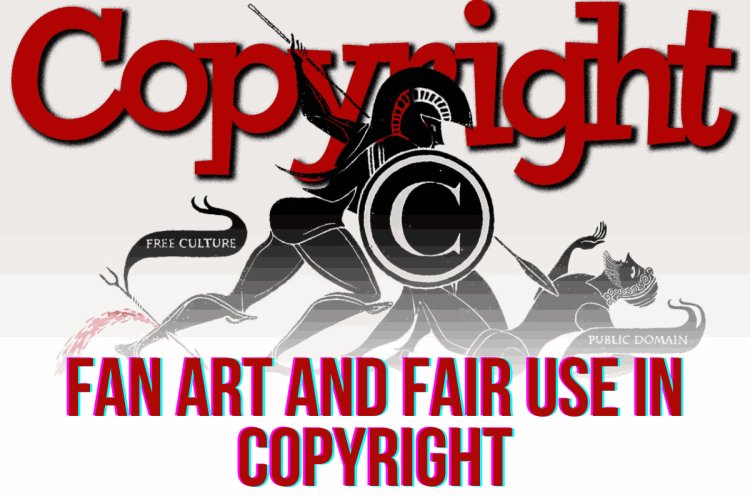Fan Art and Fair Use in Copyright
This article explores the intricate intersection of fan art and copyright law within the context of the Indian Copyright Act of 1957. Focusing on the transformative nature of fan art and its fair use status, the discussion delves into legal precedents, the commercial versus non-commercial aspects, derivative works, and the factors influencing fair use determinations. The best practices for fan artists in India, along with insights from significant case laws, form a comprehensive guide for navigating the delicate balance between artistic passion and copyright protection.

Introduction:
Fan art is a vibrant expression of creative passion, where enthusiasts produce artistic works based on existing copyrighted material. However, within the legal framework of the Indian Copyright Act of 1957, fan art raises essential questions about the intersection between artistic enthusiasm and potential copyright infringement.
Understanding Fan Art:
Fan art, a manifestation of creative fervor by enthusiasts, involves the creation of artistic works based on existing copyrighted material. Within the framework of the Indian Copyright Act, of 1957, fan art raises pertinent queries regarding the delineation between artistic passion and potential copyright infringement.
Fan Art and Transformative Use in the Indian Context:
A critical aspect of evaluating fan art's fair use status in India lies in its transformative nature or we can say it’s a grey area in the Indian Copyright Law. Transformation, involving the addition of new meaning or context to the original work, is a pivotal consideration under Indian copyright law. The Act doesn't explicitly define transformative use, leaving room for interpretation.
Legal Precedents within India:
While Indian copyright law doesn't have a direct equivalent of the fair use doctrine, legal precedents provide insights. The case of Amar Nath Sehgal v. Union of India (2005) emphasizes the delicate balance between protecting intellectual property rights and fostering creative expression, setting a tone for transformative works. The case of Lenz v. Universal Music Corp. (2008) (USA) established that transformative works, such as parodies or fan creations, are protected under fair use. However, each case is unique, and outcomes may vary based on the specific circumstances.
Commercial vs. Non-Commercial Fan Art:
Similar to global copyright considerations, the commercial nature of fan art influences its fair use status in India. The potential market impact on the original work is a crucial factor, and non-commercial fan art may be viewed more favorably in fair use analyses.
Derivative Works and Copyright Licensing in India:
The creation of derivative works, a common aspect of fan art, engages with the exclusive right of copyright holders to create adaptations. Some copyright holders may choose to license or permit fan art through official channels, providing a legal avenue for fan expression.
Factors Influencing Fair Use Determinations in India:
- Nature of the Original Work: Highly creative or fictional works may receive more protection under Indian copyright law.
- Amount and Substantiality Used: The extent of borrowing from the original work is a significant factor in fair use evaluations.
- Market Impact: Adverse effects on the market for the original work may weigh against fair use.
Best Practices for Fan Artists in India:
1. Clearly Transformative: Ensure that fan art is clearly transformative, adding significant creative elements or commentary.
2. Non-Commercial Use: Opt for non-commercial purposes to enhance fair use considerations under Indian law.
3. Attribution: Always credit the original creators in line with ethical artistic practices.
4. Permission or Licensing: Explore obtaining permission or licensing arrangements, respecting the exclusive rights of copyright holders.
Some of the important case laws in fair use are defined as under:
1. Shemaroo Entertainment Ltd Vs News Nation Network Pvt Ltd
Shemaroo Entertainment Limited, a film content house, sued News Nation Network Private Limited for using their copyrighted content without permission. The defendant claimed "fair use" for news reporting, but the court rejected their argument, citing the context of use, nature and extent of use, lack of transformativeness, availability of alternatives, and potential market impact. The court granted an interim injunction in favour of the plaintiff.
2. Tips Industries Ltd v. Wynk Ltd. And Anr
The Plaintiff claimed that the Fair Use Defense for Defendants was not applicable in this case, as Defendants' use of their music repertoire through download and purchase features competed directly with the Plaintiff's right to sell and rent its works. Defendants argued that their use was permitted under fair dealing exceptions. However, the court rejected the Defendants' defence based on the commercial nature of their activities, which directly impacted the Plaintiff's potential market and revenue. The court found the excessive taking of the entire repertoire further weighed against Defendants' claim of fair use.
Conclusion
Fan artists in India need to consider legal precedents and adhere to best practices to navigate the delicate balance between protecting intellectual property rights and fostering creative expression. Transformative use is a crucial factor in determining fair use. Non-commercial use, proper attribution, and exploring licensing arrangements are crucial steps. Recent case laws emphasize the courts' scrutiny of context, nature, extent, transformativeness, availability of alternatives, and market impact in fair use determinations. By respecting copyright holders' rights and adhering to best practices, fan artists can contribute to a culture of creativity within the bounds of copyright law.












